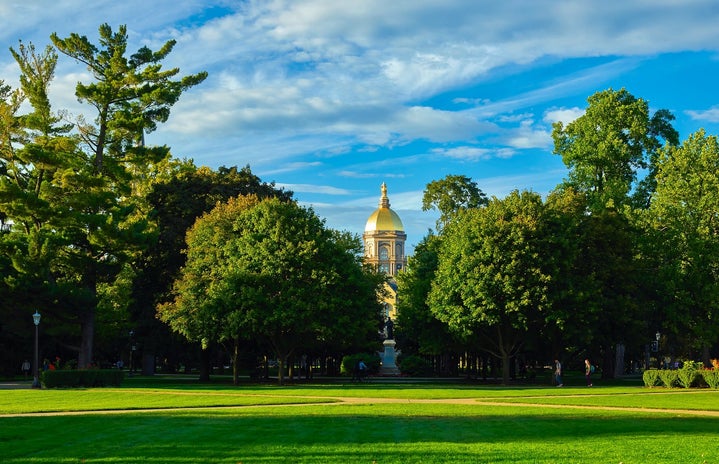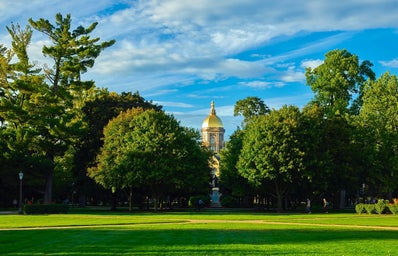Having been at Kenyon for over six months, I’ve come to have a very definite idea of how I see my life here. The campus, the community, the image we perpetuate, and the causes we champion are aspects of the hill that I feel are outlined very solidly in the collective conscience of those of us who experience them. Because Kenyon is such an isolated community, though, I often wonder what those outside of the “bubble” think of us. Some of my friends, who mostly go to huge, public state schools, tell me that they see Kenyon as a collection of ridiculously affluent, privileged kids masquerading as counter-culture hipsters. There is a glimmer of truth to this characterization, but I decided to consult a source who can look back on her college experience with a degree of separation from modern stereotypes: my mom.
My mom, Barb, went to one of the massive universities so foreign to us Kenyonites: from 1978 to 1983, she attended Kent State, a different world altogether than what we experience in Gambier. When I asked her how she views Kenyon as a school, she described it as, “The world’s most customized learning experience.”
At Kent State, as with other large schools, a limited number of resources have to serve a huge student body. This means that there isn’t the room for specific interests and personal advising that Kenyon has. As my mom put it, students at Kent had to work for a customized academic life, whereas at Kenyon, it is provided for us with enthusiasm and accessibility.
One aspect of my mom’s college dynamic that I believe Kenyon could learn from is Kent State’s diversity. The student body, though mostly composed of students from Ohio, was as diverse as any other college campus in the eighties. In terms of race and socioeconomic class, for example, my mom observed at Kenyon a homogeneity that wasn’t present on her own college campus. This prompted a discussion of what Kenyon could do to improve our admissions processes to promote diversity, namely instituting a truly need-blind process to better serve students from historically disadvantaged backgrounds.
What I was really curious to question my mom about was the political climate on campus during her undergraduate years. Watching election coverage at the Gund Gallery, seeing candlelight vigils pass me on Middle Path, and witnessing demonstrations protecting the most basic of human rights have characterized my college experience so far. As I stood and shouted with my friends in front of the White House, I distinctly remember realizing that the Women’s March on Washington would be a definitive moment in my young adult life. Given Kent State’s history with activism, I figured that my mom’s experience would be rather similar to mine.Surprisingly, she characterized her campus as conservative, both politically and in terms of demonstration. Other than annual events commemorating May 4th, the campus didn’t engage in demonstrations or protests. In my mom’s experience, Kent State was a place that appreciated and honored tradition, making it difficult for a substantive wave of change to come through. The late 1970s and early 1980s were also something of a recovery period for campuses. Having been identified as birthplaces of the anti-war, civil rights, and other various dissent movements, college campuses were eager to revert to the role of providers of an exclusively educational experience.
As she looked back on the days spent in the library and the picnics with her friends on her own first year quad, my mom mentioned a comment made by another Kent student of her time. This peer lamented the lack of activism on campuses, like it was a trend that was popular for a short time before relenting to administrative restrictions and dying out. Mom wholeheartedly agreed: in her experience, loud, dramatic activism on college campuses effectively draws attention to causes and makes a difference in legislation. It seems that those outside of the Kenyon community—or, rather, our “bubble”—see that we have an opportunity to make change and encourage us to take advantage. Remember back in 2004, when Gambier was the last precinct to deliver presidential votes (despite hours upon hours of waiting, Kenyon students persisted in order to cast their votes)? For a small campus with a tiny but impactful population and wonderfully unique peculiarities, we can attract a lot of attention, and deservedly so. If Kenyon weren’t an important group capable of making change, why did Tim Kaine visit right before the election?
While we present a stark contrast when set against the personality of larger, better-known schools, Kenyon’s community certainly has a lot to offer. Remember my mom’s advice: we are capable of affecting change, and we should use the indescribable charisma of Kenyon to make it happen.

